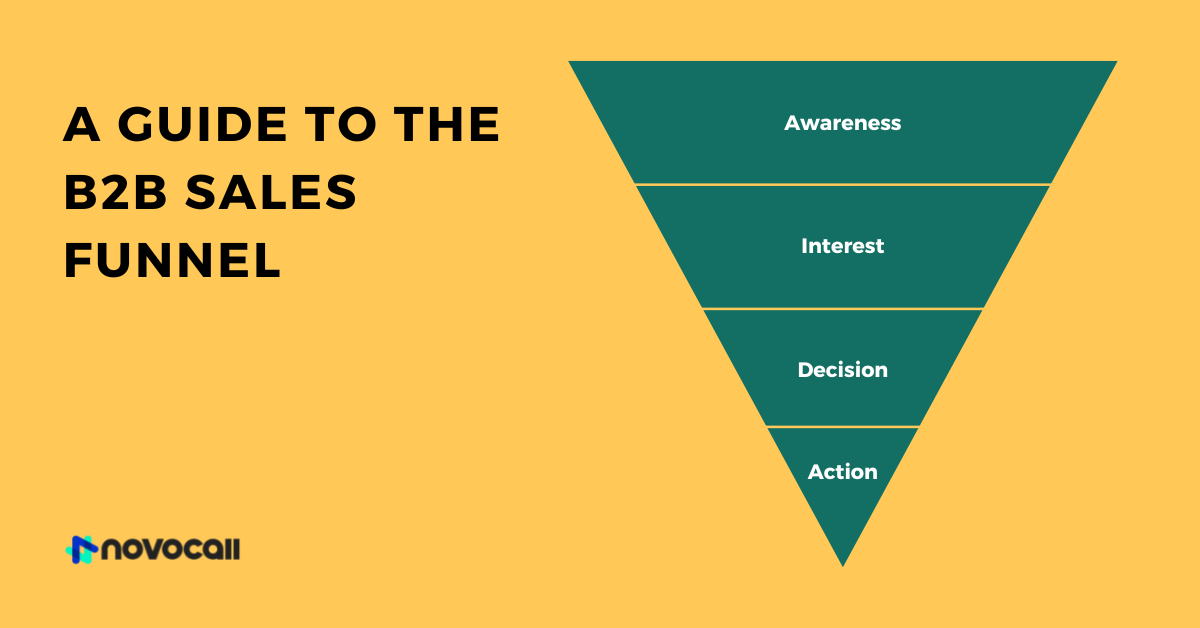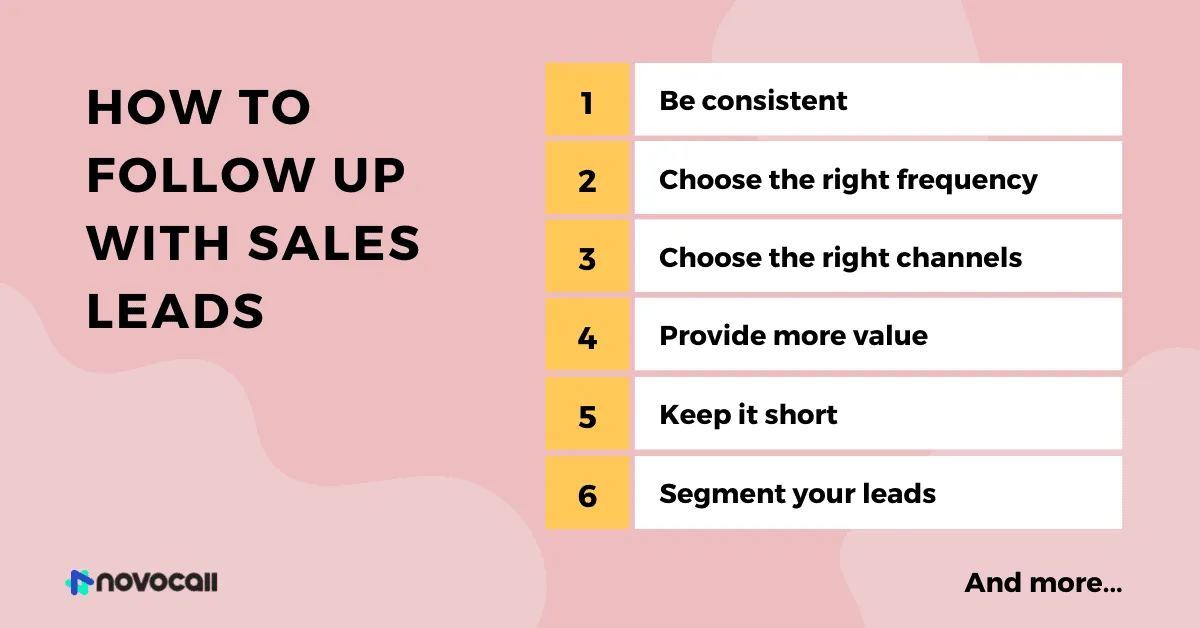


Start driving better conversations.
Novocall will be your new favorite business phone system.

Only 2% of sales leads buy after the first contact with a sales rep. The other 98% wouldn’t respond to a call, are busy, or are simply not ready to buy. Should you count it as lost sales?
The answer is: No.
You shouldn’t treat these as lost sales and completely give up! You can still change the narrative by following up diligently with your leads. After all, 80% of deals are closed after the 5th follow-up!
In this article, we’ll share 8 tried-and-tested tips to help you follow up the right way and show the tools that can be helpful in the process.
How many times should I follow up? What’s the magic number of times you should follow up? How many follow-ups are just too many?
Unfortunately, there is no easy or direct answer to your questions.
That’s because every lead is different. Some leads might need just a little nudge with one follow-up and others, dozens of follow-ups have to be made from different channels before you get a response.
The best thing you can do here is to be consistent in your communications and always remember to follow up with them.
For example, if a lead says they need two weeks to think about your offer, be sure to log this into your CRM and check back in with your lead when the time comes. If a lead doesn’t state a specific date, be sure to ask when’s the best time for them, and schedule your follow-up call or email.
The right frequency to follow up contributes significantly to your sales success. If you follow up too frequently, your leads can find it annoying. If you procrastinate, you might lose a lead to your competition. So what’s the best time to follow up?
Here’s a rough outline that you can follow:
But keep in mind that in your business niche, you might need to follow up less or more frequently than mentioned above. Do some testing to modify the frequency to fit the preferences of your leads.
Also, referencing past leads or existing clients to find out how many times it took to follow up before closing a deal is a good indicator.
Companies reach out to their leads in many different ways — some find email the most effective, while others prefer to get a quick response over the phone or schedule an appointment.
Of course, traditional forms of communication might work great for others as well.
The point here is that you have to choose the right channel when following up with leads, and consider using them interchangeably. For example, following up through emails and calls.
If you choose email as your main follow-up medium, consider working out short yet actionable email sequences and make sure you automate them. Work on eye-catching email subject lines as these can determine whether your follow-ups will be a success or a failure (as with most emails).
For phone call follow-ups, you can stick to the rule of three calls and a voicemail. Leads who don’t respond to your calls might not find this channel the right for them, don’t want to talk, or any other reasons and will eventually find this practice annoying.
Social media is another channel that can work for some businesses and leads. Most sales teams choose to follow up on LinkedIn as many sales professionals use the business platform regularly.
When it comes to fax follow-ups, not many companies are practicing it, making this channel less crowded. You’d be surprised that many companies are still using fax machines, especially in more conservative sectors. So why not give it a try sometime?
When sending your offer to a client, you can expect a few or even dozens of companies to bombard your lead with a similar or even better offer than yours. So how can you stand out?
Instead of simply stating the features of your product or service, focus on how you can benefit your client. How will you solve their challenges? How will their future processes be streamlined if they decide to buy from you?
Sending over helpful resources can also give your clients the push they need — think case studies, guides, or certain use cases that are relevant to them.
Sales emails are not newsletters — the shorter they are, the more likely your prospects will respond to them. Let’s put it straight — people are busy and checking emails or responding to sales calls is rarely their priority.
Follow-ups shouldn’t be too lengthy — you’re not sending newsletters or making sales calls here. Your leads are busy people and you don’t want to take up too much of their time. Furthermore, responding to such follow-ups are rarely their priority (hence, the need to follow up in the first place).
To achieve your goals faster, you have to keep things brief and aim to bring the conversation to the next step — scheduling a demo or arranging a meeting.
You can be contacting leads at different stages of awareness about your brand and products. Some of them might or might not be ready to buy your products.
By segmenting your leads, you can adjust your messaging to the specific needs of your prospects.
For example, a sales targets who you meet at a conference and had a chat with will be more receptive to your offer as they’re warm leads. On the other hand, leads whose emails you’ve just downloaded from an email search tool are cold leads, which tend to be less receptive.
You can divide your lead lists and assign the lead status — hot, warm, or cold depending on the lead source, your previous interactions with them, and their interactions with your website.
When you finally get a response from your lead, make it a priority to write, call back, or contact them through any channel. If your leads are asking you additional questions to them make a decision, quickly reply them to the best of your abilities.
That’s why lead response management is so important. The more your leads wait for a response, the more time your competitors have to make their offer, and let’s face it — some people just won’t wait and look somewhere else.
Your leads might contact you through various channels. While you won’t miss their email or fax, calls can quickly slip through the cracks.
That’s why it’s crucial to ensure there is someone who can handle the call, collect the necessary information from a lead, and pass over the notes to you, so you can reach out later.
In certain situations, continuing to follow up multiple times might not make sense. Some cases include when a customer has clearly rejected your offer or asks to unsubscribe from your email list.
To add on, cold leads who haven’t given you any clear response about their interest (or in this case, disinterest) shouldn’t be on your follow-up list.
Persistently contacting such leads despite their rejections can harm your business reputation and be extremely time-consuming. This can, in turn, reduce your sales productivity and ultimately affect your sales numbers.
Follow-ups are crucial in the sales process because they can help maximize sales. To ensure a successful follow-up strategy, you have to approach your leads through various channels — phone, email, chat, or even conventional meetings.
Remember that there is no one-size-fits-all plan for follow-ups. By working with the target market, referencing past data, and conducting A/B testing, you’ll be able to figure out the most effective way to reach out to your leads.
For more of such tips and advice, check out our blog!

Margo is a freelance growth marketing strategist. She creates content that converts website visitors into paying customers for SaaS companies by building sales funnels.
Related articles
Subscribe to our blog
Get insights & actionable advice read by thousands of professionals every week.

